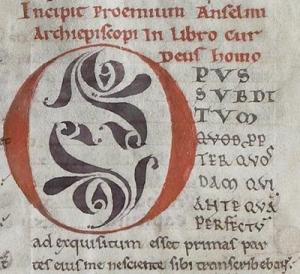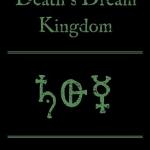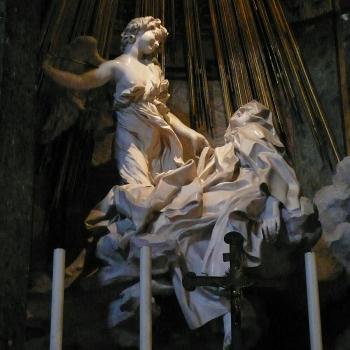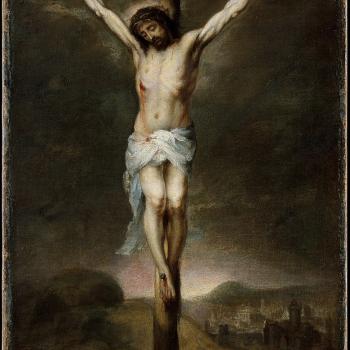 >In my project of revisiting my past in prayer, I’ve reached 1998, the year of my conversion. (And in certain ways a moral low point, which is a weird thing to recognize about the year you became a Christian.) I re-read St Anselm, probably for the first time since college and maybe for the first time ever. Not the “ontological proof of God,” which has never done much for me: Let’s all do math on a rollercoaster, and at the end, we’ve proved Platonic Forms. No thanks. But readers of Gay & Catholic may remember that Cur Deus Homo, Anselm’s dialogue on the Incarnation and Crucifixion, was maybe the single most important book in my conversion.
>In my project of revisiting my past in prayer, I’ve reached 1998, the year of my conversion. (And in certain ways a moral low point, which is a weird thing to recognize about the year you became a Christian.) I re-read St Anselm, probably for the first time since college and maybe for the first time ever. Not the “ontological proof of God,” which has never done much for me: Let’s all do math on a rollercoaster, and at the end, we’ve proved Platonic Forms. No thanks. But readers of Gay & Catholic may remember that Cur Deus Homo, Anselm’s dialogue on the Incarnation and Crucifixion, was maybe the single most important book in my conversion.
What would it be like on third (or second) reading? CDH is the only piece of Scholastic theology I’ve ever really loved–would it still compel and startle me, or would it seem rigid and legalistic, even punitive?
Oh gosh, you guys, St Anselm is so great. Here are some notes from the re-read. I apologize if I get anything wrong here, & welcome correction. I’m not going to try to summarize his central argument, although I was relieved to find that I did an okayish job of it in G&C despite being too lazy to actually go and re-read it back then. (Work is a four-letter word.) I still find it compelling as well as consoling. A++++ would convert again.
# What leapt out at me this time around is that Anselm consistently relies on aesthetics to explain or define his moral terms. In CDH justice = balance = order = harmony = beauty. Reason is an allied term: What is reasonable is also beautiful, even “sweet” and “desirable.” I think you could add “peace” to this list of terms which refer to different aspects of the same thing, although Anselm–or his translator, who for me was S.N. Deane–doesn’t throw that in.
Aside from the forms of balance, justice, and beauty (or “fittingness,” another aesthetic term) which play a role in the central argument, Anselm also offers various curlicues along the sides. Some of these aren’t so convincing but almost all rely on symmetries: traditional ones like the Tree of the Knowledge of Good & Evil as the wood of the Cross, or Mary as second Eve, as well as a few which I think are original to Anselm. He just really clearly thinks balance is beautiful and whenever he tries to figure out what God might do he assumes it would be beautiful and therefore just. Even the weird stuff about the number of angels is about balance.
# What the book is about, the beautiful and harmonious and fitting thing, is Jesus’ death under torture on the Cross. But CDH doesn’t come across as prettifying the Crucifixion or distracting us from its lurid horror. Anselm assumes it is shocking to us and works to show that it may also be beautiful: a restoration of order that looks like a disruption and defeat.
He doesn’t do the thing other writers on the Crucifixion have done, of really rolling around in the humiliation of the Cross. That Saving Shame book quotes Tertullian: “Why do you destroy the necessary disgrace of faith? Whatever is unworthy of God is helpful to me” because it prompts me to confess all the more shamelessly that Christ e.g. was born, was cradled in a manger, died on a cross; this is the folly we preach & the source of our salvation. Both “justice as beauty, explored using reason” and “humiliation as sublimity, explored using shock and absurdity” are true, and I’m grateful that I was drawn to Anselm early on, since my personality overall is more uhhhh Tertullianish on this question.
# We were made for happiness, and our happiness can only be complete or real when we are enjoying God. We owe God entire obedience–all our will and all our acts–and in the payment of this “debt” of obedience lies our happiness. Meanwhile God does not desire our suffering or the suffering of His Son. What He wills is obedience, and in a broken world, this obedience leads Jesus through suffering and death. Our own obedience will lead us down the same hard path, in order that we may be restored to happiness.
# Anselm is very clear that debts must be paid, and the debt metaphor recurs throughout the work (as it does in the Gospels). He’s pro-punishment, but not the way I was back then. I was very much just old man Karamazov yelling that I must be hung from those hooks!!!, and my G&C summary is somewhat distorted because I think/thought of punishment as suffering. Anselm’s understanding of punishment is about balance and restoration. He often uses phrases like “paid for or punished,” but he’s always thinking about yielding up something owed, rather than about suffering pain. Punishment or satisfaction is essentially defined as restoring not only what was wrongfully taken from God (our obedience) but adding additionally on to it.
# If that sounds like a thing you can’t do, that is 100% Anselm’s point. It’s the first plank in his argument, in fact: our inability to pay our debts and do our duty. And the thing I noticed this time is that we are morally incapable because we are human–because we participate in Man, to use Platonic language, because we participate in Adam’s fall. If there is a particular part of your life where your helplessness has become noticeable to you, where it’s inflamed or swollen and causing you shame and misery, that isn’t because you’re set apart from others. It’s your experience of a universal incapacity. Whatever you feel sets you apart from the “good people” (those creatures of myth), your addictions or your sexuality or your temper, the way you can’t seem to stop yelling at your kids or screwing up at work–all of that actually unites you to common human experience. You share that incapacity with the people you most admire, with children in the womb, with all the children of Eve.
# Anselm is utterly confident that God wills our restoration, and will go to any lengths for us. He does gesture at some aesthetic arguments for that: How could a God Whose will is beauty leave us writhing in our ugliness? It’s not fitting that His creatures should never be able to enjoy the happiness for which He made them! But he mostly just assumes we all agree that God wills our rescue. This confidence is as bracing and encouraging as any of his specific arguments.
# He’s not a master of dialogue like Plato. I always champion dialogue over treatise, but the dialogue form does less work here than it does in e.g. Aelred’s Spiritual Friendship. The one thing it does do (other than letting us giggle when Anselm, who does not come across as even slightly vain or intellectually proud, makes his interlocutor reply with the equivalents of, “It is assuredly so, Socrates”) is allow Anselm to clarify what he thinks he can and cannot do here. He states that he’s not trying to convert or convince people–although I was in fact converted and convinced! He’s trying some things, to see if they can help us understand the faith we already hold. This modesty may be partly performative, but it’s also a way of warning the reader. A couple times he notes explicitly that God’s ways, including the specific questions under discussion, are beyond human reason.
His theology avoids any hint that we could comprehend and thereby master God, and in fact recalls us to the littleness of our reason. He wants us to deepen our gratitude for our salvation by seeing its justice and beauty, but he doesn’t ever want us to think we can fathom it.












